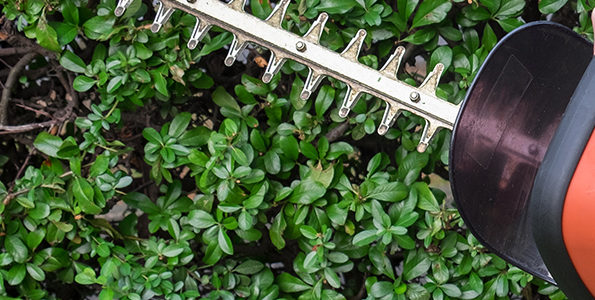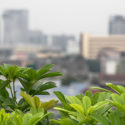I hate to burst your bubble, especially after such a hot summer in the GTA, but it’s time to start getting your garden ready for winter. That doesn’t mean that you need to give up on gardening; in fact, there are still many things that you can do to enjoy your outdoor spaces, and to get them ready for next spring. The nice sunny days of fall are also a bit cooler than the scorching heat of July, so you can spend more time out in the garden and enjoy it for a little longer before it’s time to hang the pruners up for the season. Here are a few things to think about for fall gardening.
Take stock of the hits and misses
This summer was hotter than normal in the GTA. As a result, you probably saw things bloom earlier than you thought they might, and possibly last for a shorter period than in past. My neighbours were complaining that their daisies were about 8 inches shorter than in the past, and lasted about a week less. Although it was an atypical summer, you can still assess what worked and didn’t work in your outdoor spaces. Take a look at your outdoor space (and consult your notes if you took them through the season), and identify what you liked, what you didn’t liked, what worked, and what didn’t work. Then try and figure out why things were good, or not so good. Here are some starting places:
Sun/Shade:
If some of your plants thrived in their space, you’ll know what you can plant there (permanently) next year. On the other hand, if some of your plants got sunburned, you’ll need to find a shady space for them next year; and similarly if they were too shaded, they will need more sun next year. In my new (to me) house this year, I was growing lots of fruits and vegetables but there are several large trees that shade my backyard. I used VegTrugsTM on wheels so that I could move them along into the sunnier spots of my space as the summer went along. I also experimented with different varieties of seeds over the summer to see which ones grew best in the conditions I have. Knowing which areas of your outdoor space get sun/shade throughout the summer will help you with your garden plan and allow you to plant for permanent beds more successfully. If you’re balcony gardening, the nice thing for you is that it’s generally fairly simple to move planters around in the summer to take advantage of lighting conditions, but if you have a more permanent seating area, you’ll now know how to best maximize it for next year.
Colour scheme:
Now that you’ve gone through the season, reflect back on what plants bloomed when. Did you have a period where there wasn’t enough colour in your garden? That could be because the perennials aren’t there to bloom throughout the summer. At the same time, were there times where there was too much colour? Too much or too little colour can be from flowers and foliage. Reflect on what bloomed, when, and what colours dominated throughout the summer, and then consider planting more perennials that will help you have all-season interest, or transplant some of your perennials to other spaces so that the colours around your space are complimentary. If you’re in a high/low rise, your plants are closer to the building, generally, so you can reflect on how well they stood out against the building/railing, and what you may want to adjust next year.
Water & Soil:
Again, we had a very dry summer in the GTA so this is going to be tricky to assess, but it’s important to consider the soil and watering conditions. If your plants needed more water than you could provide with your schedule or watering restrictions (either self-imposed or municipally imposed), perhaps more drought-tolerant plants would be in order. At the same time, a common mistake is that people overwater plants in hot/dry conditions. Plants do get tired in the midday sun so look at them early in the morning, or closer to sun down to see if they perk-up. With all the heat and sun this summer, you may have inadvertently overwatered when you thought you were helping your plants. You also want to look critically at your soil conditions. Some plants, such as ferns, hydrangeas, blueberries, like really rich organic soil; while other plants, like lavender, sage, and yews, like sandier soil that drains well. It’s important to figure out what soil conditions your plants favour so that you can amend the soil appropriately. That may mean adding compost or organic matter, like the PREMIER BIOMAX range of products to your garden beds, so that you can start spring with the appropriate pH balance in your soil.
General hits/misses:
Think about what you liked/didn’t like about your outdoor space this summer. If you’re in a balcony, was it too windy to be able to keep up with the watering? If so, perhaps you need a screen to take away some of the breeze; or you’ll know that as amazing as it might be, you’re just not going to have the success you hoped for with tomatoes on the 27th floor. In that case, maybe put your name on the list for a community garden plot next summer. Regardless of your space, did you like what bloomed? Were the colours interesting? Did you enjoy the space? Were you stressed by the maintenance or did you find yourself enjoying more time in the garden than you thought and think you want to add more? If you loved the annuals you planted, take note and pick them up again next year. If you didn’t like them, think about why and make a note so that next year you can find something different.
After considering the above, if you don’t know why something in your garden didn’t go well, take a trip to your local garden centre and ask their experts for help. Bring photos of your space (if you have them), and tell them what was going on. They’ll be able to help you figure out what was happening. If you’re working from a blank slate, this may be the time to get a design that can get you started for next year. Knowing what worked and didn’t work in your space can help you and a designer come up with a plan that can start to be implemented for success in years to come.
Get ready for next year
The fall is a great time to get started on next growing season. If you’ve decided to go the design route, many things can get started to spread out the cost and timing of the project. If you’re going to do it yourself, there are many things to do in the fall:
Repair that grass (or tear it out):
This summer’s hot, dry conditions, certainly didn’t favour successful lawn maintenance, and that’s okay. In fact, it’s normal. Grass is supposed to go dormant in the summer, it shouldn’t be green all summer-long. But if you weren’t a fan of the brown look, consider a drought-tolerant seed such as PRO-MIX Ultimate All Condition Grass Seed. You can also use a lawn fertilizer like PRO-MIX Premium Heal & Feed Lawn Fertilizer that is intended for less watering, better stress tolerance, stronger roots, and less maintenance. The fall is a perfect time to patch up the lawn if you’re going to keep it and the PRO-MIX Ultimate All Condition Grass Seed will even germinate in lower temperatures so you can seed well into this fall. This summer showed that grass is hard to maintain and water-intensive, which is harder on the environment, so a drought-tolerant seed is preferable. If you decide the lawn look isn’t for you, you can also use the fall to take it out, and start getting the soil ready for next year. There are many things you can do without a grass that are interesting and will help your house to stand apart, particularly when all the houses in the neighbourhood generally look the same.
Winterize your plants:
For those of you on the balcony, you may find that on those cool fall nights you want to take your plants indoors as the smaller pots they are in make them more susceptible to the cold. You can also figure out what plants you are going to keep in your indoor space over the winter. I actually had an orange tree on my condo balcony that I would take indoors for the winter. The trick was finding a space with lots of light, but being careful not to have the tree against a window where there was a draft. For those of you with outdoor gardens, some things, like rose bushes and young trees, will need to be protected for the winter. In the fall take the time to mulch around the base of them, and some trees may need a tree-guard to protect them from the cold, and from animals over the winter. Your local garden centre should be able to provide advice on winter care.
Plant, prune, and transplant for next spring:
If you know that you need to add colour, move plants around, or add “more” to your space, now is the time to get ready. The fall is great for planting (and transplanting). Once you have a plan and know where plants need to go, you can plant or transplant accordingly. Certain trees and bushes should be pruned once they have finished blooming to keep them in shape and help them to bloom successfully next year. In condos you’ll need to empty the pots at least half way and start with fresh soil next year. If you can do that in the fall it will be less heavy than trying to do it over the winter when the soil is frozen. You can still do some greens and decorating for winter in your planters, but they don’t need as much soil.
There are many projects you can take in the fall to get ready for next year. A critical assessment of your space is the first step to know what to do next. Follow the steps above to get a design or get advice from your garden centre to have a great space. The important thing is that in the fall you start thinking towards next year and getting ready for a year of great enjoyment of your outdoor space.



